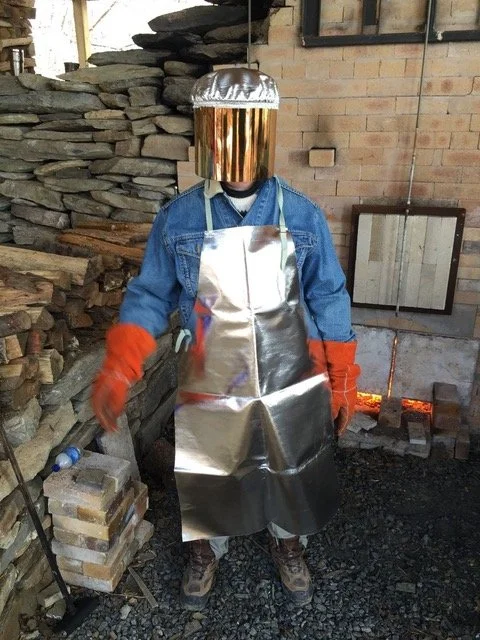On May 1st I got a lovely email from Kate Bradford. She is an industrial hygienist (occ health and safety) as well as a potter and has specifically researched safety hazard risks to potters.
Not only does Kate know how to protect against the dangers of wood firng she has done the leg work and found some reasonably-priced sources for things like I have listed below.
So I wrote Kate back and she agreed to help me put together a shopping list for woodfire PPE (Personal Protective Equipment) to make sure we are all using the right stuff and not overpaying for it.
Here is Kate’s husband all tricked out for full safety during a wood firing. I recently had a really good conversation with Linda Christianson about good safety gear, and how it makes you relaxed and able to do you job well without hurry or stress, which benefits the firing. Hurrying a stoke or overcompensating because the firebox is too hot to approach can damage the ware you are working so hard to produce.
Ken Kaufman modeling good behavior
Make it stand out.
-
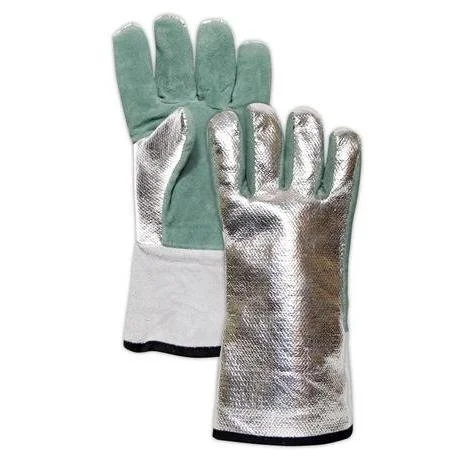
Firing Gloves
Magid® WeldPro® DJXG1575 Aluminized Carbon Kevlar®/Leather Welding Gloves
https://www.magidglove.com/Magid-Aluminized-Carbon-Kevlar-Gloves.aspx (Kate paid $39.15/pr)
-
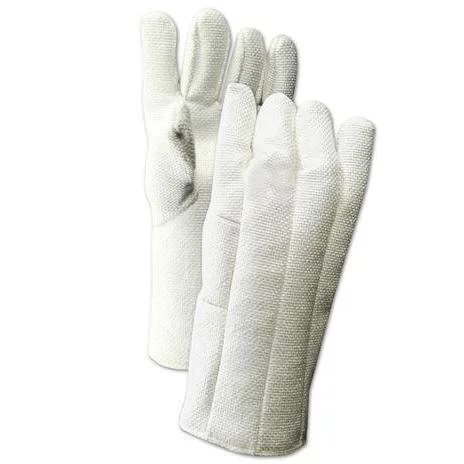
Firing Gloves
Magid® ZT1314WL Zetex® High-Heat Gloves
https://www.magidglove.com/Magid-Zetex-ZT1314WL-High-Temperature-Safety-Gloves-ZT1314WL.aspx (46.40/pr)
-
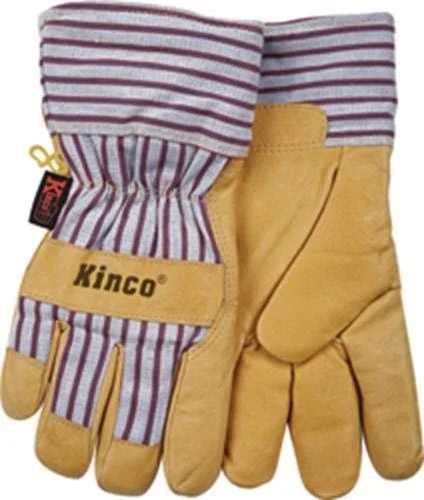
I like these insulated Kinco Gloves, they have more dexterity than the three fingered gloves, and the insulaton keeps the heat out as much as it keeps your hands warm in the winter. These have been really durable, slow to wear through and resistant to heat and abrasion.
https://www.amazon.com/Tillman-Premium-Cowhide-3-Finger-Welding/dp/B003GM83IA/ref=sr_1_8?keywords=Three+finger+welding+gloves&qid=1556723449&s=gateway&sr=8-8
-

Firing Gloves
Three Fingered Tillman Welding gloves on Amazon.com. $19.99
https://www.amazon.com/Tillman-Premium-Cowhide-3-Finger-Welding/dp/B003GM83IA/ref=sr_1_8?keywords=Three+finger+welding+gloves&qid=1556723449&s=gateway&sr=8-8
These three fingered Tillman gloves kind of act as reverse mittens, dissapating heat around each finger. I have had too many fingers on welding gloves get really hot and bend backwards rendering them unusable, or had to remove my hand from the glove while it cools down. Never have I had to do this with these gloves. The three finger thing takes a little getting used to, and most people love them or hate them. I believe they last longer because they dont wear through a single finger near as fast.
-

Firing Gloves
Kate’s Husband’s Favorite Firing Gloves
RAPICCA Leather Forge Welding Gloves Heat/Fire Resistant, $19.99 on Amazon
https://www.amazon.com/gp/product/B01N1VJDIQ/ref=ppx_yo_dt_b_asin_title_o08_s00?ie=UTF8&psc=1
-
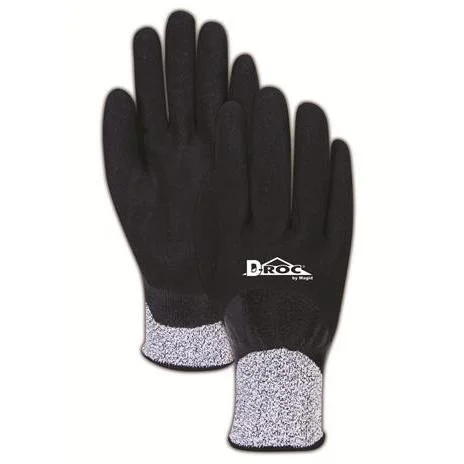
Unloading Gloves
Magid® D-ROC® GPD730 Hyperon™ Blend and Nitrile Double Dip Full Coat - Cut Level 2
For handling things that could cut hands (like broken pots, rough wood, etc) but where you still need a high coefficient of friction for proper grip, these are inexpensive and ANSI-rated as cut resistant: https://www.magidglove.com/Magid-D-ROC-GPD730-Hyperon-Gloves-with-Full-Nitrile-Coating-and-NitriX-Grip-Technology-Coating.aspx (I paid 6.60/pr)
EYE PROTECTION
What’s most important is to have something that is ANSI-rated again IR/UV exposure, and you don’t especially need something like blue (didymium) lenses to do this as long as they attenuate IR/UV sufficiently.
-

Kate was given a pair of these to try, but hasn’t used them much: Uvex 880 series Klip Lifts. Best price seems to be from Amazon. $38.00
-
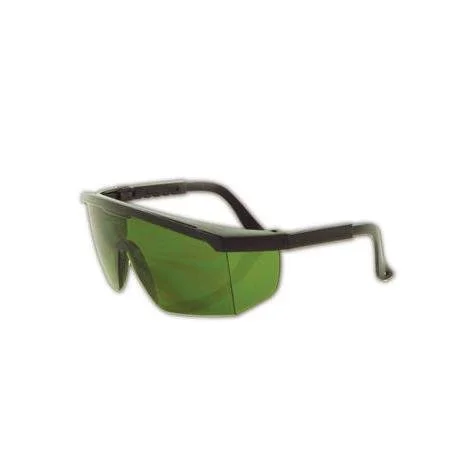
This is a fairly inexpensive option: Magid Gemstone Sapphire Y30 (but be sure to get the 5.0 IR rating). These are good for checking cones as long as there isn’t significant heat Magidglove.com $3.90 pr.
Kate really seems to like the Oberon Face Shield when there is a lot of heat, though it works when you gazing at cone packs as well. You do need to get both the shield and the ratchet gear
-
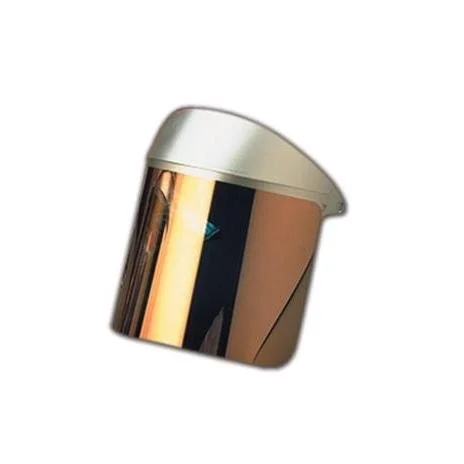
Oberon® FF4025 8"x14" Heat Reflective Faceshield (Kate’s price: 66.90)
-

Rachet Headgear (10.05)
Respirators are definitely not ‘one size fits all’ - either in terms of size or model.
Most important is to match the respirator’s filter to the hazard.
For dusts (glaze, dry chemicals, etc.), a well-fitting N-95 filter should be appropriately protective assuming that the face piece fits/seals well.
[Extra info: ’N-95’ means that it filters out at least 95% of particles down to 0.3 microns in diameter, but is not resistant to oil. The most protective dust filter is a P100 - which means it filters out 99.97% of particles down to 0.3 microns and is resistant to oil. P100 filters are the old “HEPA”, or high efficiency particulate air filters.]
During the heavy reduction phase of wood firing, the black smoke coming out of the kiln contains polycyclic aromatic hydrocarbons (PAHs). Recommend using a respirator with an organic vapor cartridge to protect against PAHs
Some filters/cartridges can be used in combination. For instance, a 3M paint cartridge protects against both organic vapors and also has a P100 pre-filter.
Disposable N-95 respirators work reasonably well against dusts when sanding, mixing dry clays or glazes, or cleaning up kilns. Getting a disporable N-95 respirator with an exhalation valve tends to make them more comfortable than a hospital-type N-95 disposable because they tend to trap less moisture.
I prefer an elastomeric half-face respirator because it seals better and tends to provide more protection.
Be sure to buy the same manufacturers' filter cartridges as the respirator face piece (i.e., a 3M with a 3M, or Honeywell with Honeywell, etc.).
Note: size is determined by the distance from the bony bridge of the nose to the chin. Medium is supposed to fit the majority of the population, but sometimes women need a small - not necessarily because of the size of the face/head, but because - in my case - the distance from nose to chin is short.
It’s a good idea to learn how to do a fit-check on a respirator. Here’s a link to a YouTube video on how to conduct a fit-check. (This is how to conduct a fit-check on a disposable N-95 respirator.)
-
My favorite respirator is a 3M half-face with a combination acid-gas/organic vapor/P100 filter (it pretty much covers everything!). Here are links to what I bought:
-
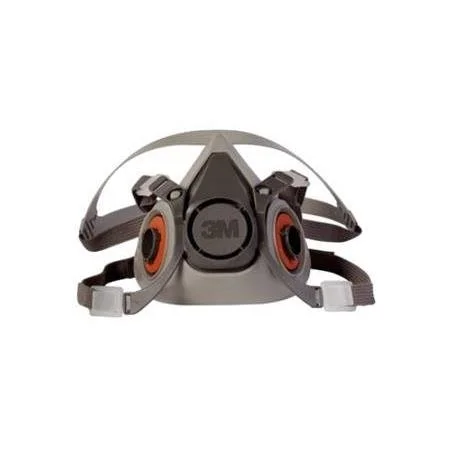
3M 6000 series Half Facepiece $11.25
-
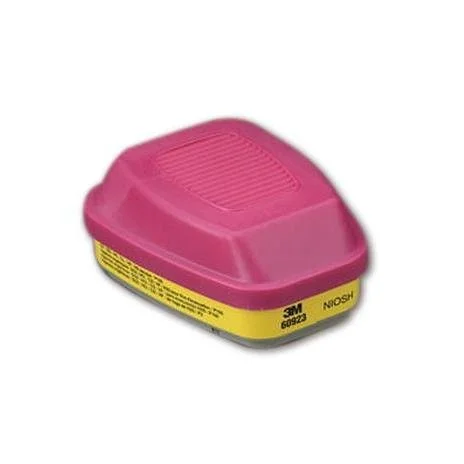
3M OV/AG/P100 filter cartridges (1pr) Organic Vapor/Acid Gas $19.70
Hearing Protection
Folks should wear hearing protection whenever it’s noisy enough to have to raise your voice to be heard or if you find it too loud to comfortably carry on a conversation.
Hearing loss is gradual and tends to affect high-frequencies first. If it seems like people are mumbling more, it might be because we are affected by noise-induced hearing loss (NIHL). If this is starting to happen, first - you can save money because you won’t need top-end stereo equipment (you won’t be able to hear the difference!), but second - it’s important to protect what hearing you have left.
There are lots of different types of hearing protection, but the best kind is what’s comfortable for you. I prefer corded ones like these, but the most important thing is to find something comfortable. Here’s a link to various types.
Many folks like muffs, but sometimes hard to wear if also using safety glasses or a respirator.
National Institute for Occupational Safety and Health (NIOSH) has a free app for smartphones that measures noise in decibels. It might be worth finding out how loud things are. Try to wear hearing protection whenever noise levels are above 85 dBA.
